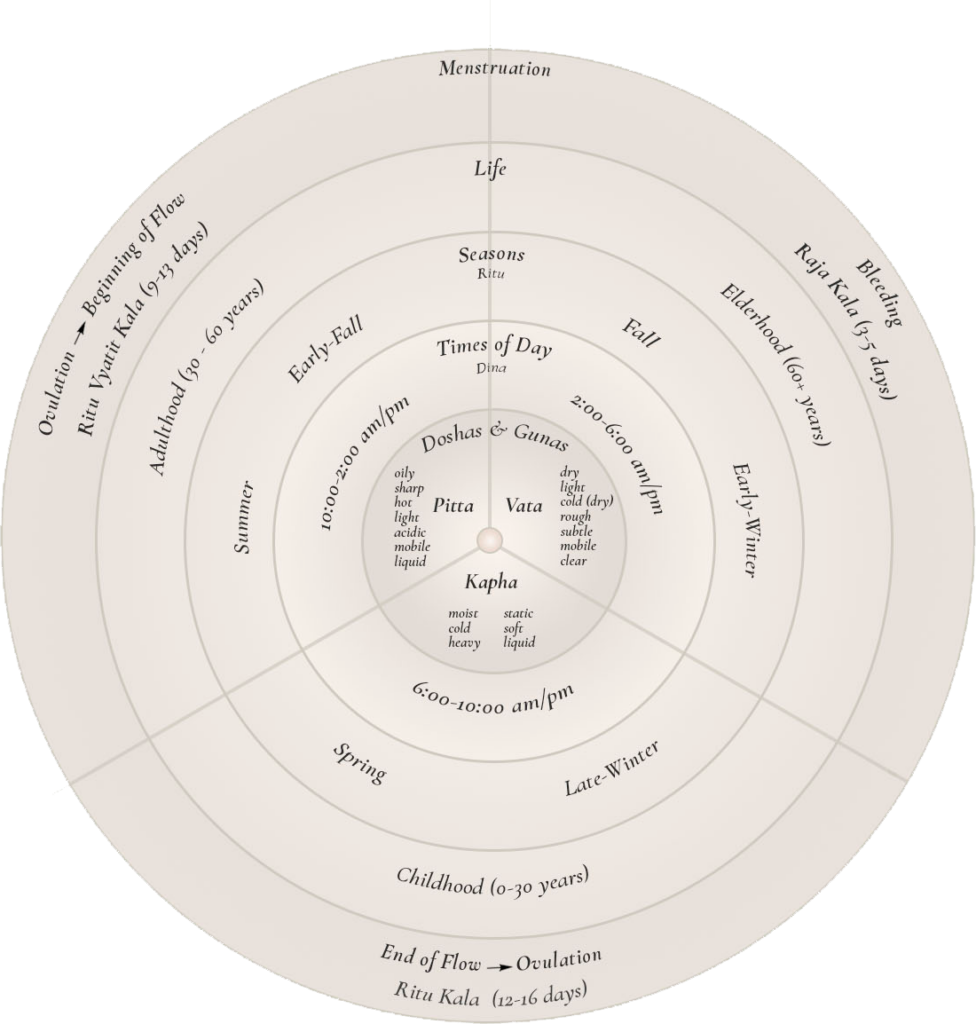
The Ultimate Guide to Embracing Cyclical Living
Bridging Ayurveda and Modern Science
Cyclical living encourages us to align with the natural rhythms of time—solar, lunar, seasonal, and life stages. When we live in harmony with these cycles, we reduce allostatic load—the physical and mental strain that builds up in the body when systems are overworked, leading to changes in metabolism and wear and tear on our organs and tissues. This alignment enhances our energy, health, and productivity while fostering a deeper connection with nature and ourselves.
Ayurveda is a beautiful time-tested science that illuminates natural cycles and offers guidance for cultivating habits that align with nature’s rhythms. In this article, we’ll explore Ayurvedic recommendations to support cyclical living.
This Ayurvedic cyclical living guide explores FOUR LEVELS OF NATURAL CYCLES and how to work with them intentionally.
1. Daily Rhythms (24-hour)

Align Daily Routines with Circadian (24hr) Rhythms
The Ayurvedic clock, informed by Circadian rhythms, helps us structure our day based on the dominant doshas at specific times
- Vata (2–6 AM/PM): Creativity and innovative tasks that require more mental agility, meditation, and light activity thrive, e.g. enjoying nature on a light hike or stroll. Early mornings and afternoons are ideal for reflection and light movement.
- Kapha (6–10 AM/PM): Grounding, cooling and steady energy. Morning exercise, including more intense physical activity and evening winding down work well here.
- Pitta (10 AM–2 PM/PM): Digestion and focus are at their peak. Have your largest meal (best time for heavier meals/meat) at midday and focus on highly analytical tasks. Engaging in less intense physical activity during Pitta time is ideal, as it helps counterbalance the natural heating energy of this period. Gentle, cooling practices are best to maintain harmony and avoid overheating.
Practical Tip: Structure your day to honor these rhythms, such as eating your heaviest meal during Pitta hours and reserving physically intensive activities for Kapha times.
2. Lunar Months
Live in Sync with Your Menstrual Cycle
A woman’s menstrual cycle mirrors the lunar cycle, offering a guide for self-care and productivity.
- Follicular – Bleed (Vata): Rest, release, and introspection. Reduce stimulation and prioritize grounding rituals.
- Follicular – End of Bleed to Ovulation (Kapha): Build strength and nurture relationships. Plan for social or creative activities.
- Ovulation (Pitta): Energy and clarity peak. This is the time for high-impact projects or physical activities.
- Luteal Phase (Pitta transitioning to Vata): Focus on finishing tasks and preparing for rest as energy begins to wane.
Practical Tip: Track your cycle and adjust your schedule to align with these natural energy fluctuations.
Here’s a diagram I created to quickly see the correlation between lunar cycle, and the western breakdown of menstruation as well as the ayurvedic dosha breakdown.

3. Seasons
Embrace Nature’s Annual Rhythms (Circannual Circadian Rhythms)
Each season corresponds to a doshic energy that can guide our habits, foods, and routines:
- Spring (Kapha): Focus on light, energizing practices to shake off stagnation. Think fresh greens, early-morning exercise, and detoxing rituals.
- Summer (Pitta): Stay cool and hydrated. Eat lighter meals and focus on calming, grounding activities.
- Fall (Pitta/Vata): Balance the dryness and movement with warming, nourishing foods and grounding practices.
- Winter (Vata/Kapha): Prioritize warmth, rest, and introspection. Eat heavier, cooked meals and indulge in restorative rituals.
Practical Tip: Adjust your diet and daily routines with the changing seasons to maintain balance and harmony.
4. Stages of Life
Honor Each Phase with Intention
Ayurveda teaches us that life is divided into three overarching stages (these can be further subdivided and nuanced, e.g puberty, pregnancy, or peri-menopause), each dominated by a dosha:
- Childhood (Kapha): Growth and nourishment are key. Prioritize grounding routines, unprocessed whole foods, and warmth.
- Adulthood (Pitta): Productivity, creation and transformation. Focus on balance by managing stress and cooling Pitta’s intensity.
- Elder Years (Vata): Rest and reflection. Embrace warmth, stability, and routines that calm the nervous system.
Practical Tip: Acknowledge the needs of your current stage of life while cultivating rituals that support long-term health.
Bringing It All Together: Living in Harmony with Cycles
Transitions are not abrupt shifts from one energy to another but a gradual flow, where one dominant energy softly gives way to another. These periods of change are predominantly influenced by Vata energy, characterized by instability, movement, and transformation. This concept applies not only to seasonal transitions but also to life’s stages.
By embracing the interconnected cycles of solar, lunar, seasonal, and life stages, we cultivate a harmonious, intuitive, and balanced life. This Ayurvedic cyclical living guide serves as a general roadmap to help you develop an intimate relationship with your internal rhythms.
Fun fact: Many religious and cultural fasting practices, such as Ramadan (Islamic), Ekadashi, Navaratri, and Mahashivratri (Hindu), or Yom Kippur (Jewish), were traditionally aligned with seasonal transitions marked by lunar or solar events. During these times, when metabolism is naturally less efficient, fasting was believed to support optimal digestion, while quieter, contemplative lifestyles encouraged a deeper connection to divinity, spirit, and emotional stability.

